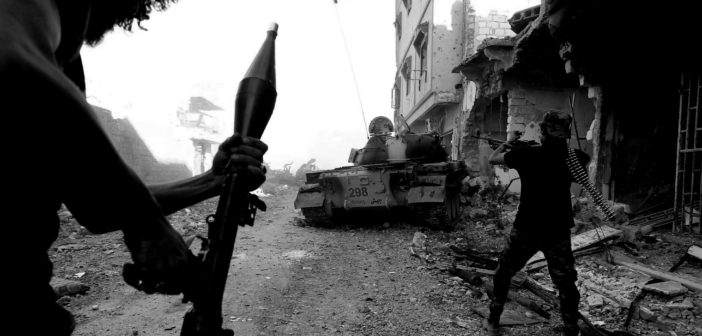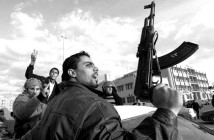Despite the expulsion of the Islamic State (IS) in Libya from Sirte and Benghazi the past year, the group started to reorganize and was able to attack both Libya National Army and Misrata militias. In May 2017, the terrorist group targeted a convoy belonging to the Misrata Third Force, a controversial militia suspected of war crimes in the so-called “Brak al-Shati massacre” the same month by killing 134 people in LNA ranks, and among civilians some of them simply executed. Since last summer, the group cracks down in an area located between As Sidra / Ras Lanuf oil terminals and Sirte by conducting security patrols, establishing checkpoints, and carrying attacks by ambushes and with IEDs. By the end of September, 17 IS militants were killed in US Air Force armed drone strikes on a camp located 150 miles (240 km) southeast of Sirte. On 4th of October, Islamic State claimed responsibility for the suicide attack on a court complex in the Libyan city of Misrata by killing at least four people and wounding nearly 40. Such attacks show that IS still has the capacity to launch terrorist operations on a larger scale. More recently, on Nov. 17th and 19th, US forces conducted two drone airstrikes near Fuqaha in central Libya against IS militants in coordination with Government of National Accord (GNA).
 Despite the resurgence of the Islamic State and the sending of reinforcements by both LNA and militias of Al Bunyan Al Marsous in an area located between Sirte and the oil terminals, we will not witness a rapprochement between the two main forces in a common “operation room” to fight the same enemy. On the contrary, tensions increase while new massacres and war crimes are committed by both sides. Indeed, whereas extrajudicial executions seem to have taken place by the end of October in the district of Al-Abyar – located 50 km east of Benghazi – where 36 men were killed in execution style, and in general attributed to major Mahmoud Al-Warfali – an officer of al-Saiqa Special Forces, a LNA Special Forces unit – already under a warrant for his arrest by the ICC for war crimes, GNA affiliated forces are accused of the killing of 28 people – among them are LNA soldiers most having torture and execution signs –southwest of the Libyan capital in Wershafana area after fighting between Zintan Military Council’s forces and the LNA’s Fourth Brigade. To this must be added the massacre of 20 civilians in Derna when Egyptian Air Force (EAF) carried out airstrikes on position of supposed militants ready to join and cross the Egyptian-Libyan border. Current dynamics play into the hands of the extremist groups, in particular the Islamic State, but groups with ties with al-Qaeda as well. The fear of an attack on the oil crescent infrastructure worries the Tobruk government as LNA spokesman said two months ago. Such a threat seems increasingly plausible while LNA Air Force intensifies reconnaissance missions and carry out air raids against supposed IS militants, and convoy of vehicles southern Ras Lanuf. The latest airstrikes were performed on Nov. 15th against a storage facility and hideout 90km south of Harawah.
Despite the resurgence of the Islamic State and the sending of reinforcements by both LNA and militias of Al Bunyan Al Marsous in an area located between Sirte and the oil terminals, we will not witness a rapprochement between the two main forces in a common “operation room” to fight the same enemy. On the contrary, tensions increase while new massacres and war crimes are committed by both sides. Indeed, whereas extrajudicial executions seem to have taken place by the end of October in the district of Al-Abyar – located 50 km east of Benghazi – where 36 men were killed in execution style, and in general attributed to major Mahmoud Al-Warfali – an officer of al-Saiqa Special Forces, a LNA Special Forces unit – already under a warrant for his arrest by the ICC for war crimes, GNA affiliated forces are accused of the killing of 28 people – among them are LNA soldiers most having torture and execution signs –southwest of the Libyan capital in Wershafana area after fighting between Zintan Military Council’s forces and the LNA’s Fourth Brigade. To this must be added the massacre of 20 civilians in Derna when Egyptian Air Force (EAF) carried out airstrikes on position of supposed militants ready to join and cross the Egyptian-Libyan border. Current dynamics play into the hands of the extremist groups, in particular the Islamic State, but groups with ties with al-Qaeda as well. The fear of an attack on the oil crescent infrastructure worries the Tobruk government as LNA spokesman said two months ago. Such a threat seems increasingly plausible while LNA Air Force intensifies reconnaissance missions and carry out air raids against supposed IS militants, and convoy of vehicles southern Ras Lanuf. The latest airstrikes were performed on Nov. 15th against a storage facility and hideout 90km south of Harawah.
In the past, the oil crescent infrastructures were attacked many times by armed groups as the Saraya Defend Benghazi — also known as Benghazi Defense Brigade — an Islamist militia group with ties with al-Qaeda that formed in June 2016, in coordination with elements of the Ibrahim Jadhran’s Petroleum Facilities Guard. Beginning December 2016, a convoy of around 150 vehicles left Al Jufrah in central Libya and split into two sections as it approached the Oil Crescent. One of the convoy’s two sections attacked Nofaliya and then Bin Jawad town, 20 miles west of As Sider and the other half hurried to make contact with LNA ground forces, apparently in order to make it more difficult for Haftar’s helicopters and MiGs to strike from above without also endangering friendly forces. Despite this, LNA’s aircraft struck back hard and repelled the attack. Three months later, a convoy of 50 vehicles from Saraya Defended Benghazi together with members of Ibrahim Jadhran’s Petroleum Facilities Guard and Misrata’s Al Marsa Brigade, attacked simultaneously An Nawfaliya, Bin Jawad, Es Sider and Ras Lanuf. It seems that the convoy went undetected, despite the United Arab Emirates having deployed Wing Loong drones to Libya’s Al Khadim air base in order to support Haftar. The SDB’s offensive took Haftar, and indeed the world, by surprise — especially considering Haftar’s efforts to reinforce his positions in the Oil Crescent following the SDB’s previous assault, but this time they were able to seize their objectives. Ten days later, after several counter-attacks, the LNA retook the cities one by one, as well as the airport at Ras Lanouf with the probable aerial support from the United Arab Emirates or Egypt – or both – as the Libyan National Army was (and is still) running out of air power.
Egypt is no longer hiding its direct support for the Tobruk government. In late May, by using as pretext the ISIS murders of 28 Coptic Christians in a monastery in Egypt’s Minya province, Egypt Air Force performed many air raids on the cities of Derna against Derna Mujahideen Shura Council (DMSC) – an Al-Qaeda-affiliated coalition of Islamist militias that formed in December 2014 – and Hun – the SDB stronghold – in al-Jufrah area. Cairo accused the DMSC to have supported the ISIS attack although it is this same DMSC that chased IS from Derna in 2015 … Following multiple losses in its air force – mostly due to technical problems on aircraft old as hell – the LNA no longer has the ability to counter a future attack on oil terminals.
A conflagration in the oil crescent would bring Libya back three year’s. Islamic State suicide car bombers that would attack Ras Lanuf or Es Sider could set on fire oil storage tanks. On the other hand, maritime assault as supposed IS militants attempted in January 2016 on the oil port of Zueitina seems unlikely as LNA’s maritime surveillance helicopters – notably the Agusta A109s and gunship Mi-35s – patrol permanently along the coast.
Nevertheless, a series of coordinated attacks at different strategic points cannot be ruled out in the coming weeks …




